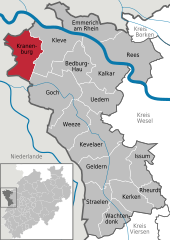Kranenburg, North Rhine-Westphalia
| Kranenburg | ||
|---|---|---|
|
||
| Coordinates: 51°47′23″N 6°0′26″E / 51.78972°N 6.00722°ECoordinates: 51°47′23″N 6°0′26″E / 51.78972°N 6.00722°E | ||
| Country | Germany | |
| State | North Rhine-Westphalia | |
| Admin. region | Düsseldorf | |
| District | Kleve | |
| Government | ||
| • Mayor | Günter Steins (CDU) | |
| Area | ||
| • Total | 76.96 km2 (29.71 sq mi) | |
| Elevation | 21 m (69 ft) | |
| Population (2015-12-31) | ||
| • Total | 10,648 | |
| • Density | 140/km2 (360/sq mi) | |
| Time zone | CET/CEST (UTC+1/+2) | |
| Postal codes | 47559 | |
| Dialling codes | 0 28 26 und 0 28 21 | |
| Vehicle registration | KLE | |
| Website | www.kranenburg.de | |
Kranenburg is a town and municipality in the district of Cleves in the state of North Rhine-Westphalia, Germany. It is located near the border with the Netherlands, 12 kilometres (7 mi) south-east of Nijmegen and 11 kilometres (7 mi) west of Cleves. Since 1992, Kranenburg has evolved into a commuter town for Nijmegen, . The village has always focussed on the Dutch city of Nijmegen, and the local language was Dutch until far into the 19th century. More recent, the extremely large influx of Dutch financially driven, cross-border migrants has changed the profile of this small rural border town significantly, resulting in social discomfort and unrest with the native German population.
First records show that Kranenburg was founded in the 13th century by the Baron of Kleve. The first castle was built in 1270 and the first church a few years later by († 1277). In 1294, the village raised to the status of town. In 1308 "The Miraculous Cross" () was found, establishing Kranenburg as a place of pilgrimage. According to legend, a boy went into the forest after church and spit out his communion wafer. After a while he felt guilty and confessed to the pastor. Together they went back into the forest to find the wafer. At the tree where he had spit it out, the cross now stood.
In 1370, the county came into the possession of the von Kleve family line again, after it had been leased to knight, of Horne and Weert, Lord of Perweys, Lord of Herlaer, and later his son, the bishop . During this time the town got its first fortifications. At the end of the 15th century, a new castle, substantial stone fortifications with 2 gates and an, up to this point unknown number of towers were erected. The most southern of these towers acted as the town windmill (Stadtwindmühle). The town bloomed most prosperously during the first half of the 15th century, which resulted in the construction of the large, Gothic . In 1436, the was moved to Kranenburg from Zyfflich, in 1445/46 followed by the Augustinian women's nunnery , which was established in the Kranenburger Mühlenstraße as an axillary branch of the Klever Nunnery of Mount Sion (Schwesternhauses vom Berg Sion). After a fierce religious feud over the new prince bishop within the Münster Cathedral Chapter since 1450, the Kranenburger Treaty was signed in Kranenburg in 1457, assigning John II of Pfalz-Simmern as the new prince bishop.
...
Wikipedia




